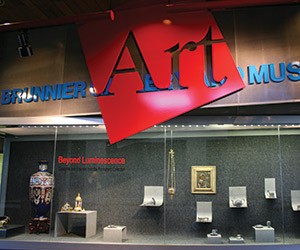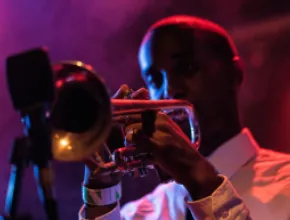Iowa's population grew at double- and even triple-digit rates throughout the latter half of the 19th century, and most of those new faces were immigrants from various spots in northern Europe, especially the Netherlands and Scandinavia. As a result, central Iowa is dotted with buildings and even entire towns that are microcosms of period culture and architecture.
But while preserving its history, Central Iowa cities and towns have also built distinctive cultural, sports and convention facilities, ranging from modest theaters to one of the nation's biggest and busiest state fair complexes.
It's tensions like these—present and past, urban and rural, artistic and practical—that give Central Iowa venues a dynamism that planners can benefit from when creating agendas.
The following is a selection of standout venues and group experiences in Central Iowa.
Brunnier Art Museum, Ames
www.museums.iastate.edu
On the top floor of the Scheman Building—the Iowa Events Center's conference facility—is a full-blown art museum. The Brunnier has a permanent collection as well as a variety of shows throughout the year, and those rotating shows can be tied to conferences if planners use some of the Scheman's 21 dedicated meeting spaces, says Julie Weeks, executive director of the Ames CVB.
"We hosted the National Order of the Arrow Conference this year, and they worked with the Brunnier to do something on the whole history of Scouting," Weeks says.
C.Y. Stephens Auditorium, Ames
www.center.iastate.edu
Located in the Iowa Events Center and adjacent to the Scheman Building, C.Y. Stephens Auditorium was named the Building of the Century in 2004 by the American Institute of Architects Iowa chapter, which described it using terms such as "audacity" and "powerful sculptural quality" and lauded its architectural "mastery." And it's highly functional as well as beautiful, according to the Ames CVB's Weeks.
"It is an amazing facility with perfect acoustics, if your event has an entertainment component to it," she says. "There are no seats with a hindered view."
Iowa State Fairgrounds, Des Moines
www.iowastatefair.org
Any doubts planners might have about holding a big event in modestly populated Central Iowa should vanish as they approach the Iowa State Fairgrounds just south of downtown Des Moines. In 2012, the fair welcomed nearly 1.1 million visitors in 11 days, and visitors got to see a great deal thanks to the fairgrounds' wide range of facilities.
"A couple of years ago the New York Times said it was one of the top 10 things to do before you die," says Greg Edwards, president and CEO of the Greater Des Moines CVB.
The fairgrounds have continually expanded its permanent facilities. The latest major addition occurred about two years ago, when the Jacobson Exhibition Center opened as the newest arena, ideal for horse and other agriculture-related shows, although it's also a logical choice for beach volleyball tournaments and small concerts.
In addition, the fairgrounds have several permanent large-scale animal barns, an amphitheater, a cultural center, various stages and a racetrack with accompanying grandstand, as well as a full-time planning and events staff.
Living History Farms, Des Moines
www.lhf.org
This venue celebrates Iowa agriculture as practiced over the past three centuries and features a 1700 Ioway Indian Farm, an 1850 Pioneer Farm and a 1900 Horse-Powered Farm.
"This is a great facility and tourist attraction for us to educate young and old on farming in Iowa," the Greater Des Moines CVB's Edwards says. "It will take you from Native American farming to present-day farming, and probably the biggest attraction is the late-1800s town they built there."
The town, called Walnut Hill, is populated by historic reenactors and features a period drugstore, general store, church, blacksmith shop, print shop, mansion and other buildings. Tours of these sites take three to four hours, and Edwards says it's a great place to hold off-site meetings or retreats.
"They can cater your meals, add the ambience of horse-drawn wagon rides, and have the historical interpreters on staff to make your outing a bit different," he says.
Grimes Farm, Marshalltown
www.grimesfarm.org
Although nine in 10 acres of Iowa are used for agriculture, there is also a modest counter-movement to restore the state's original tall-grass prairie and forests where feasible. Grimes Farm is one sign of this movement. Over the years it has slowly accumulated 700 contiguous acres of depleted land that is steadily being restored to a mix of native prairie grassland, forest and sustainable farmland.
The owners are estimated to have planted 200,000 bur oak, sugar maple, white pine, cherry and red oak trees while also recreating wetlands and prairie. A new observation tower lets visitors see the sweep of what the Grimeses have accomplished here since 1964.
An accompanying conservation center has meeting space, according to Shannon Espenscheid, director of the Marshalltown CVB.
"There's an interactive learning center—they have some meeting space as well—and you can have meals catered in, and then you have that outside experience on trails and a lookout tower," she says. "It's not your typical meeting if you wanted to do team-building there."
Orpheum Theater Center, Marshalltown
www.orpheumtheatercenter.com
This 1949 Arte Moderne-style theater has been extensively updated thanks to a combination of grants and community fundraising, and now serves as a both a cinematic and live-performance venue. Its auditorium, black-box theater, meeting rooms and famed Coffee Shop (complete with a team of baristas known as the Caffinettes) are all available to groups.
Salisbury House & Gardens, Des Moines
www.salisburyhouse.org
In the 1920s, cosmetics magnate Carl and Edith Weeks built a 42-room, Tudor-style mansion modeled on the King's House in Salisbury, England. Situated on 9.5 acres of virgin woodland, Salisbury House today serves as a museum and exhibition site for the Weeks' 10,000-piece collection of artworks, historic books and documents, antique furniture and musical instruments.
Groups might get the feeling they're meeting somewhere in a castle in England rather than in Iowa. Let's just say that board meetings at a 19-foot-long English oak trestle table, surrounded by ornate needlepoint tapestries, will likely be a little more interesting than the average corporate boardroom. Recent events have included an F. Scott Fitzgerald-themed, 1920s Gatsby Gala. From there, visitors can adjourn to the Great Hall for cocktails beneath rafters taken from the White Hart Inn, where Shakespeare and company performed in the 1600s.
State Historical Museum Vault Tour, Des Moines
www.iowahistory.org
Sure, Iowa's official history museum has a lot of great stuff above ground—but check out the Vault Tour, a private dip into the non-public other 90 percent of the museum's collection.
"It is really neat, it's their lower-basement level of the museum, which is incredible—from old cars to taxidermy displays of bald eagles and brown bears, antique furniture, Native American collections from pottery to arrowheads and tools—it's a very interesting place," says the Greater Des Moines CVB's Edwards.
Other items in this 100,000-piece, climate-controlled collection include Civil War battle flags, quilts, old motorcycles and automobiles, memorabilia from over a century of state and national political campaigns, grand pianos and an entire log cabin.
And when groups return to the surface world the museum has exhibits on everything from Iowa inventors to the state's role in the Underground Railroad. There is also plenty of classroom and auditorium space, as well as a beautiful atrium where receptions or banquets can happen beneath some of the museum's hanging exhibits.
"They also have a unique terrace on the top floor looking directly onto the capitol building, and it can serve for indoor or outdoor functions," Edwards adds.
Town of Pella
www.pella.org
While most towns and cities have standout venues, it's the overall atmosphere of Pella that keeps visitors coming back. Settled in the latter half of the 19th century by immigrants from the Netherlands, the town has taken pains to preserve a 360-degree Dutch-ness in its downtown Historical Village. This area includes tulips, period buildings, a canal, windmills and an animated public clock known as a klokkenspiel, according to Jill Vandevoort, director of the Pella CVB.
"Dutch architecture is very prevalent throughout the downtown and beyond," she says. "When we plan itineraries for groups, we do work with local eateries and caterers to create and serve Dutch meals to our visitors for that added 'touch of Holland,' and costumes are utilized more with group events as well."
Specific attractions here include the 1880 Amsterdam School, the antique-rich Hagens van Willigen House, the 1850s Vermeer Mill, and 1900 Pella Opera House.
Paul D. Kretkowski writes frequently about travel, food and sports. He is also the founder of Beacon, a blog about foreign policy.






